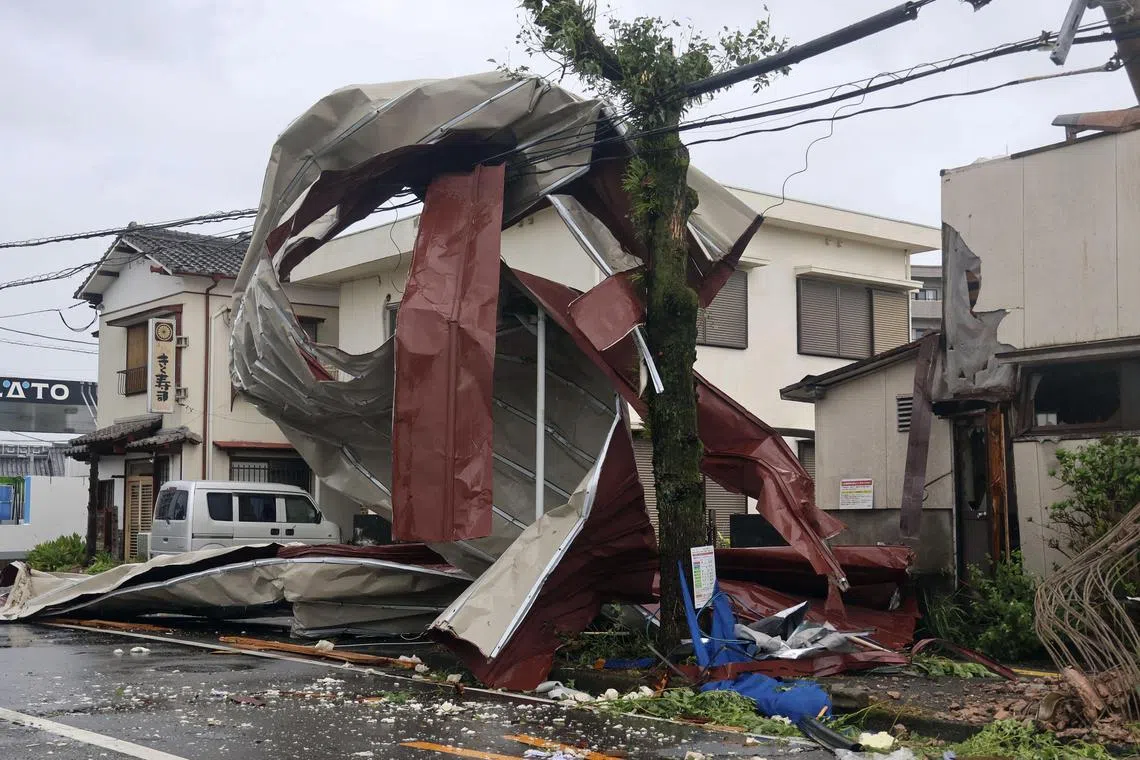Typhoon Shanshan churns over Japan, killing three
Sign up now: Get ST's newsletters delivered to your inbox

An object blown by strong winds caused by Typhoon Shanshan is stranded on a power line in Miyazaki, south-western Japan, on Aug 29.
PHOTO: REUTERS
Follow topic:
TOKYO – Typhoon Shanshan has weakened to a tropical storm after hitting Japan’s south-western island of Kyushu, with the government warning that landslides could be triggered by heavy rain as the weather system beats its way slowly across the country in the coming days.
Some areas of Kyushu saw record-breaking rain of over 800mm in the 72 hours to 3pm local time (2pm Singapore time) on Aug 29, according to the Japan Meteorological Agency.
The typhoon was located near Unzen city in Nagasaki prefecture, and moving north as at 5pm local time, it added.
Three people have been reported dead, and one person was missing due to the typhoon, which made landfall earlier on Aug 29, Japan’s Chief Cabinet Secretary Yoshimasa Hayashi said at a press conference.
A weather bureau official on Aug 28 described Shanshan as a “rare typhoon” in terms of its strength.
Rain turned rivers into raging torrents while wind smashed windows and blew tiles off roofs. TV images showed flooded roads and power lines being repaired.
The coastal city of Miyazaki, littered with debris from nearly 200 damaged buildings, reported 25 injuries – including some from a tornado.
Worried student Aoi Nishimoto, 18, said he had called his family in Miyazaki to see if they were safe.
“Our home is fine, but there was a tornado in Miyazaki and power went out in some places,” he told AFP in Kyushu’s main city of Fukuoka.
Another student, Ms Rio Ohtsuru, 19, told AFP: “This year, I am away from my parents’ home for the first time. So it’s a bit scary being all alone.
“Maybe I will look for a torch in case of a power outage.”
Kyushu’s utility operator said 187,010 houses were without power elsewhere on the island.
Shanshan comes in the wake of Typhoon Ampil, which dumped heavy rain that disrupted hundreds of flights and trains earlier in August but caused only minor injuries and damage.
Typhoons in the region have been forming closer to coastlines, intensifying more rapidly and lasting longer over land due to climate change, according to a study released in July.
Another release by the World Weather Attribution network of scientists on Aug 29 said that climate change turbocharged Typhoon Gaemi, which killed dozens of people across the Philippines, Taiwan and China in 2024.

High waves observed along the shore as Typhoon Shanshan approaches Ibusuki, Kagoshima prefecture, in south-western Japan, on Aug 28.
PHOTO: REUTERS
Toyota halt
Auto giant Toyota suspended production at all 14 of its factories in Japan. Nissan and Honda also halted operations at their Kyushu plants, as did chipmakers, including Tokyo Electron, reports said.
Mitsubishi Motors said it would halt operations at its plant in Okayama prefecture on Aug 30.
Kyushu is a hub for the semiconductor industry, with chip giant Taiwan Semiconductor Manufacturing Company opening a plant there in February.
Japan Airlines and ANA cancelled more than 1,000 domestic flights and four international flights on Aug 29 and 30, affecting more than 44,000 passengers.
Rail operators suspended most Shinkansen bullet train operations between Kyushu’s Hakata and Tokyo, and said services would be disrupted elsewhere on Aug 30. BLOOMBERG, AFP

